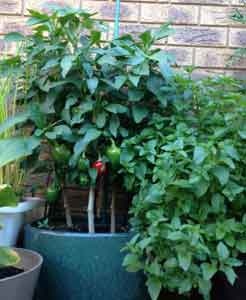One of SGA’s staunch supporters and volunteers, Gianni Montalto, tells us his experience with growing capsicum.
“Over the last few years I have reduced the veggies I grow in garden beds, and instead have been growing more in large pots. Mostly along the east facing back wall of the house.
 “The main reasons for the gradual move include:
“The main reasons for the gradual move include:
- The fruit trees in the garden have grown up, don’t let much light through and they drink up practically all the water and any fertiliser I apply, before annual summer veggies can get a foothold. This has become even more of an issue with the earlier and hotter starts to summer in the last few years. Winter growing crops like broccoli that can get established before Spring turns to summer, do fine under the deciduous fruit trees or in the exposed beds, but I then mulch and rest that ground over summer.
- Easier access – The pots are close to the back door and rainwater tanks for quick picking and watering.
- More favourable light conditions at the east facing wall – they get full morning sun until the middle of the day and then shade in the hotter afternoon, but still mostly open to the sky. The plants may wilt on really hot windy mornings, but recover in the shady afternoons.
- Better control of water – the pots sit in large dishes to catch runoff, which the plants wick up during the day.
“So being more efficient with water has been an unexpected benefit. Another revelation was finding that capsicum plants can in fact be grown over two seasons in Melbourne without a green house. I never found this possible by growing them in the ground in exposed garden beds, where they would inevitably wither and die. In the pots they grew well and produced a reasonable crop last summer. I left them there over winter, expecting them to completely die off, but they came back to life and are doing well.
“Keeping the pots under the roof eaves at the east wall over winter I think really helped. This meant they got protection from frosts and little if any rain, watering them rarely, just enough to keep the potting mix barely moist. Also, they continued to get morning sun and a fair amount of warming. The pots are ceramic so they retain some heat into the afternoon/night. I could have moved them to the north facing wall where they would have received more sustained sun over the day during winter, but that was too much work! I thought about covering them with plastic sheeting or with a temporary protective enclosure to extend the warmth of the day into the evening, but that would have reduced air circulation, increased humidity and may have resulted in mouldy plants.
“They gradually lost all their leaves and the thinner branches died off (but they did not go mouldy). The few thicker green branches that remained then began to sprout new growth as the days warmed in Spring. This was the signal to re-start watering and feeding them – I use liquid fish fertiliser at about a third the recommended rate once a week (or sometimes two or three weeks go by) and occasionally mixed manure pellets. They really took off, filling with green leaves, flowered and fruited in no time – certainly earlier in the season than last year.
“I did start with a good quality organic potting mix and I normally rotate what goes in the pots, so in the year prior to planting the capsicum, there had been a crop of basil, and tomatoes the year before that. Adjacent pots this year include basil, mint and tomatoes. The plants have not been sprayed or treated with anything.
By mid-summer the plants are still sending out new growth and flowers. The yield has already equalled last year’s crop and it has arrived sooner, which is not surprising as the plants were essentially mature plants, which just needed a warm spring kick-along to get going again.”
Related Articles:
Tomato Brown Rugose Fruit Virus (ToBRFV)
Tomato Brown Rugose Fruit Virus (ToBRFV) is a plant virus that causes severe crop losses (up to 75%) in tomatoes, but also in peppers (capsicums and…
Garden Journaling – Slow down to tune in.
As we move through the year and our gardens evolve, there's something magical about documenting the journey. Garden journaling is an art that enables…


